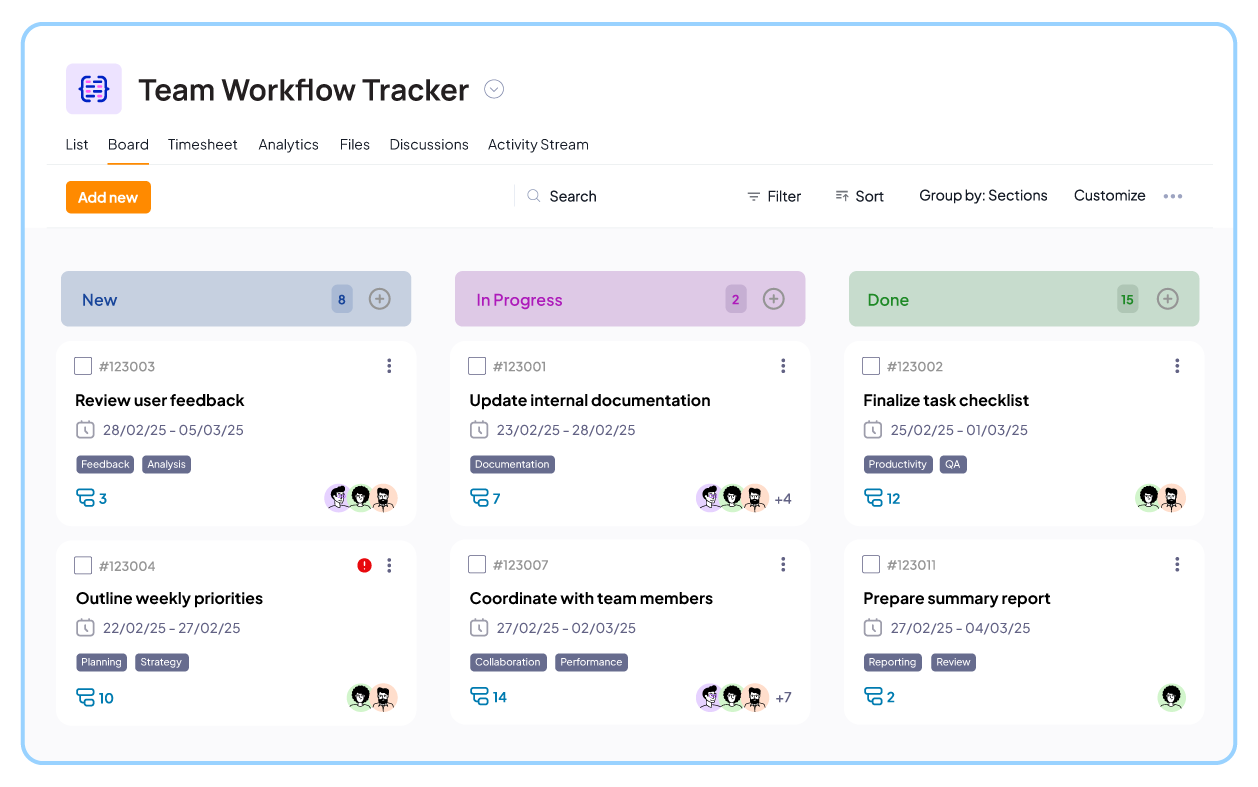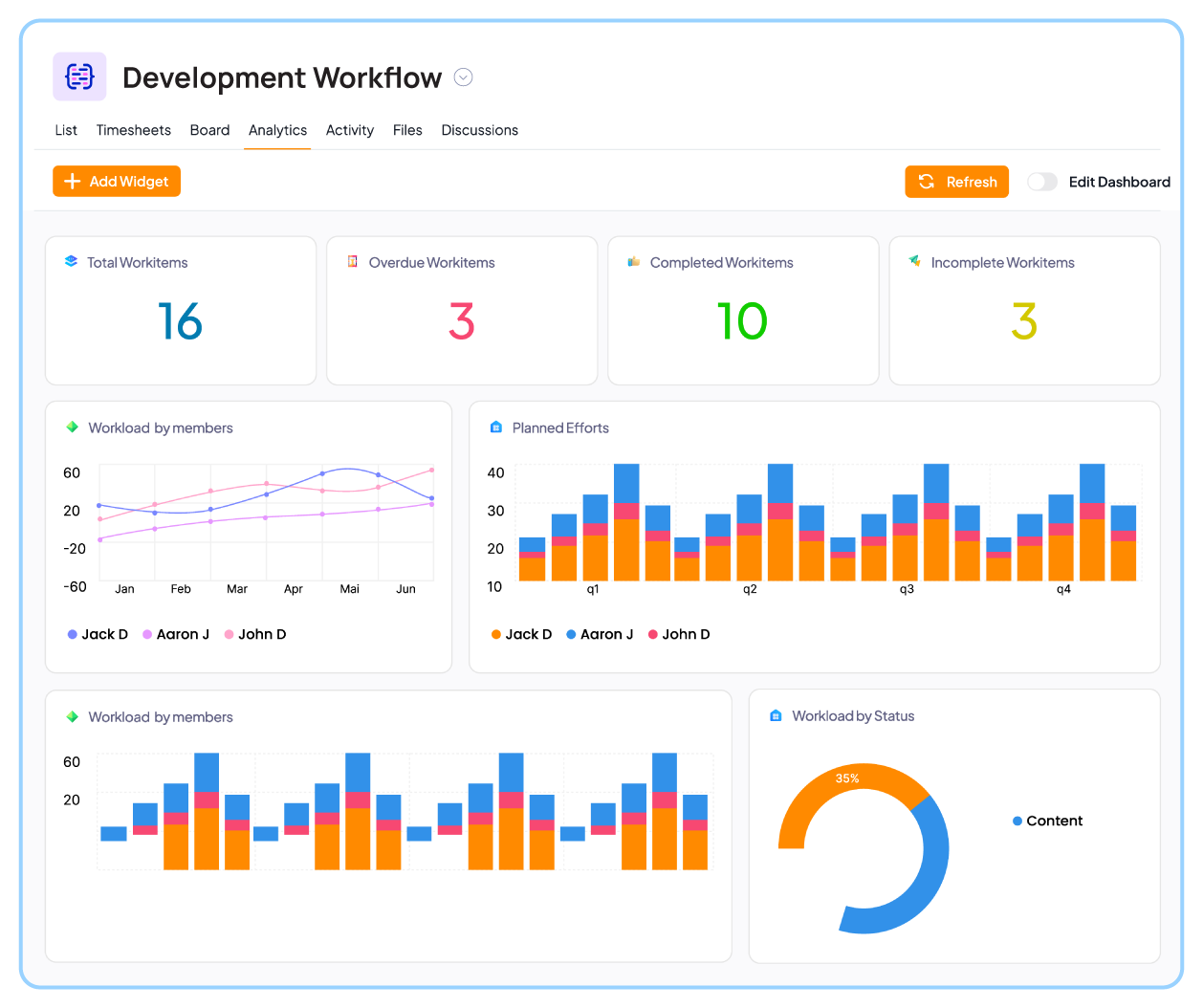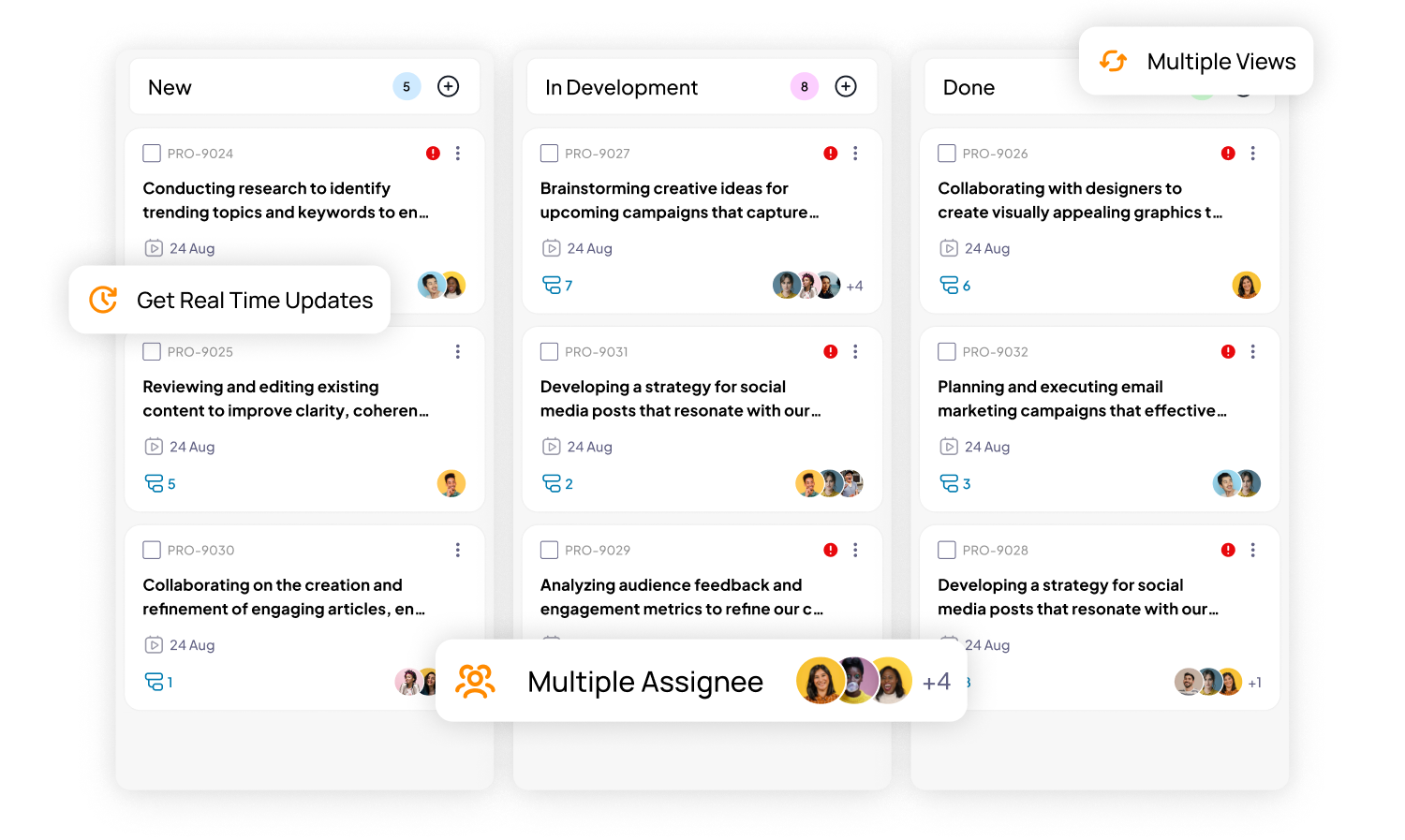Projects don’t fail in the end, instead, they fail at the start. Or worse, because the team never fully understood what phase they were in.
Structure is your best tool for a reason. That’s why the PMBOK Guide outlines five project management phases: initiation, planning, execution, monitoring & controlling, and closure, to turn chaos into clarity.
Understanding these phases helps teams avoid misalignment and scope creep. On the other hand, skipping any one of them can throw off your entire project management triangle, disrupt scope, budgets, and derail timelines.
In this article, let’s break down the phases with practical insights and real-world relevance. You’ll learn about each phase and why avoiding even one can cost you more than just time.
What are the 5 phases of project management?
A universal project management lifecycle that ensures clarity from start to finish.
Project management experts like PMI (Project Management Institute) define the project lifecycle in five distinct phases:
- Initiation – Answers questions like, is this project worth doing, and what will the success metrics
- Planning – Focuses on planning each task to cover the scope discussed in the initial phase and meet overall goals
- Execution – The goal is to deliver the work as planned, while managing collaboration and quality
- Monitoring and controlling – Measures what’s happening against what was planned, and adjusts with it
- Closure – Finishing the project and evaluating the results to learn from mistakes for future projects
Each phase acts like a milestone, ensuring your team knows where they are, what to do next, and how to adapt if things change. When a project manager understands each phase, they can see the bigger picture and anticipate challenges.
Using the right tools for each phase of project management makes the process straightforward and ensures project success.

What are the 5 phases of project management to make big tasks manageable? Let’s find out in depth.
Phase 1: Project initiation
The initiation phase is the foundation of any project. It involves defining the project’s purpose, identifying stakeholders, and assessing the project’s feasibility. Many teams start their project with an initial project kickoff meeting or feasibility study.
For this phase, you can consider discussing questions like:
- What is the fundamental purpose of the project?
- Are there any big business goals that it will help achieve?
- What are the top deliverables of the project?
- Which success metric should it fulfill?
This sets the direction and scope, ensuring that the project aligns with organizational goals.
Some key activities to cover in this phase include:
- Developing a project charter: The charter document covers objectives, scope, stakeholders, and authority levels
- Conducting feasibility studies: Determines the technical, financial, and operational potential of the project
- Identifying stakeholders: Recognizes individuals or groups related to and affected by the project
- Defining success metrics: To lay down measurable outcomes for project evaluation
Key deliverables:
- Project Charter
- Feasibility Study Report
- Stakeholder Register
- Initial Risk Assessment
Along with the key activities, you should also outline the obstacles related to the project deliverables.
Here are some common challenges in the initiation phase:
- Lack of clear goals can lead to misaligned efforts
- Unclear and differing expectations may cause conflicts
- Insufficient resources can hinder progress
Pro Tip: When creating a project charter (or product initiation document), avoid getting trapped in technical requirements. The detailed requirements will make more sense in the later phases.
Use special tools like 5day.io project management software for smooth initiation. These tools come with customizable templates to define project scope, and roles faster.
Phase 2: Project planning
You know what your project is; now the next step is to plan how to go about it. Think of planning as the blueprint stage before building a house.
Without a plan, you have no idea if you are on the right track. The plan will help figure out the timelines, how much it will cost, and how to proceed. It involves detailed guidelines for your team about tasks, resources, and communication strategies to achieve objectives.
Prepare multiple planning strategies, nailing down every minute detail.
Here are some key activities to consider at this stage:
- Defining scope and objectives: Clearly explains what the project will deliver
- Developing a work breakdown structure (WBS): Breaks down tasks into manageable components
- Creating project schedules: Sets timelines using tools like Gantt charts
- Resource planning: Allocates human, financial, and material resources
- Risk management planning: Identifies potential issues and mitigation strategies
Key deliverables:
- Project management plan
- WBS document
- Schedule and project milestones
- Resource plan
- Risk Management plan
Common challenges that teams face during this stage include:
- Uncontrolled changes and scope creep can derail the project
- Often, teams set overambitious schedules that may lead to burnout and unexpected delays
- Overlooking potential issues can cause more delays

Tools like 5day.io help you break down complex projects into structured phases. You can create and manage detailed work items and subitems, assign owners, and set timelines for each task. With features like multi-level sections, task links, and customizable views (List and Board), teams can plan without getting lost in complexity.
Phase 3: Project execution
Execution is where you put plans into action. The team starts their tasks and communicates progress to stakeholders. It is crucial to set clear rules for decision-making and change management to ensure that project objectives are met.
Some important activities covered under this phase are:
- Manage tasks by assigning and tracking work progress
- Keep a check on the quality to ensure all deliverables meet defined standards
- Managing smooth communication to keep everyone informed through regular updates
- Gather necessary resources and services
Key deliverables:
- Completed Deliverables
- Status Reports
- Quality Assurance Reports
- Updated Project Documentation
Here are some common challenges to resolve during this phase:
- Often, teams put strain on resources to meet demands
- Misunderstandings and gaps in communication may lead to errors and project mishandling
- Quality issues can crop up with deliverables that may require rework
Pro Tip: One good idea is to enhance collaboration, automate routine task creation in 5day.io with recurrence, and provide valuable insights through data analytics. 5day.io project management software offers multiple tools to monitor progress and adjust project timeline as needed.
Phase 4: Project monitoring & controlling
The project monitoring and controlling stage involves tracking project performance and making necessary adjustments. This step ensures the project stays on track, covering the scope, time, cost, and quality.
Some of the crucial activities covered in this phase are:
- Performance measurement to compare actual progress against the set plan
- Change management for handling alterations to the scope or objectives
- Risk assessment to keeping an eye on identified risks and emerging issues
- Finally, quality control to verify if the outputs meet the required standards
Key deliverables:
- Performance Reports
- Change Requests and Logs
- Updated Risk Register
- Quality Control Metrics
Challenges the team encounters during this phase include:
- Late identification of a problem worsens the situation
- Poorly managed changes can disrupt progress and further create unwanted issues
- Lack of transparency and a gap in reporting stalls right decision-making

Using dashboard analytics in 5day.io provides real-time insights into project performance and changes at the right time.
Phase 5: Project closure
Closure marks the completion of the project. It involves finalizing all activities, releasing resources, and determining if the project was a success.
It involves the following activities:
- Final deliverable handover with all the outputs delivered and accepted
- Completing documentation with all project records for future reference
- Learning what went well and finding areas for improvement for upcoming projects
- Acknowledging team efforts and celebrating their successes
Key Deliverables:
- Final Project Report
- Lessons Learned Document
- Client Acceptance Forms
- Archived Project Files
During the closure, make sure to talk with the stakeholders about any incomplete deliverables. If there are any, make a plan to address them.
Some common challenges teams face in the closure phase are:
- Missing records and reports can hinder future projects
- Unresolved problems may affect client satisfaction and overall reputation
- Failure to formally close the project can confuse teams
Pro Tip: Instead of just ticking off that project as “complete,” take time to understand the entire outcome and organize all the documents in a centralized place.
Celebrate achievements and send appreciation notes to teammates. A Harvard survey suggests that 46.4% of people feel only somewhat valued, and about 10.7% feel not valued at all in the workplace.
The importance of project management phases
When teams don’t understand the flow of a project, they start strong but struggle to finish. The 5 phases of project management give your team a rhythm, a shared language, and a way to see around corners.
Let’s break down the real benefits of mastering the project management life cycle steps:
1. Improved project visibility
This visibility allows you to
- Spot bottlenecks before they become blockers
- Make informed decisions with up-to-date progress data
- Adjust priorities without throwing off the whole plan
From timeline views to real-time dashboards, 5day.io project management software gives a high-level vision to track progress without micromanaging.
2. Easier alignment of ideas to action
When people hear “project management lifecycle,” they often picture a waterfall model. But lifecycle management doesn’t mean rigid. It means intentional. Whether you’re working Agile or hybrid, the project lifecycle phases keep ideas organized and grounded.
Using tools to add custom fields, tags, and templates helps track every item’s journey through the lifecycle.
3. Stronger communication
Miscommunication is the silent killer of good projects. But when you structure updates around project phases, your communication naturally becomes clearer and more relevant.
You can tailor updates to phase-specific outcomes (e.g., “here’s what’s done vs. still in planning”). Further, it’s easier to document decisions and hold meaningful check-ins.
Structured communication builds trust. And trust gets you approvals faster, feedback sooner, and fewer surprises down the line. With integrated discussion threads, file sharing, and custom status updates, 5day.io project management software becomes a central hub for clear, phase-aligned communication.
Choosing the right project management tool for every phase
Understanding the 5 phases of project management isn’t just for project managers. It’s for anyone who works on a team with deadlines, goals, and the need to get things done right.
When everyone shares that mental model, projects become easier to plan, execute, and improve. And when you’ve got a platform like 5day.io built around that model? You’re not just managing projects, you’re mastering the process all the way through.
Ready to create structured workflows for each phase? Check 5day.io and try all the premium features available for 3 months at zero cost.
Frequently asked questions
Which phase of project management is crucial for success?
Technically, every phase has its purpose. But if you had to point out one, it would be the first phase. It’s where the entire project becomes a success or a failure. Why? Because it’s where your project earns its right to exist.
This is where you define the why, secure stakeholder alignment, and frame the scope before setting the project in motion. A weak start here leads to unclear goals, unreal expectations, and even burnout.
Can phases of project management overlap?
While PMBOK details a neat sequence of five project management phases, projects rarely follow a linear path. Execution may begin while planning is still wrapping up, and Monitoring & Controlling should run continuously, not just after the plan is locked.
Overlapping phases make your team more responsive. But that’s possible only if there’s a shared single source of truth and real-time updates. Phases overlapping is a sign of agility, not chaos, as long as communication stays clear and intentional.
How does Agile methodology fit into these phases?
The Agile model fits right into these phases in a more iterative way, creating multiple sprints for the project. It just moves through the project management phases on repeat, turning feedback into forward motion.
Software development teams rely on constant back-and-forth collaboration and regularly update their processes with feedback. Agile teams define visions and build backlogs. Instead of a months-long Gantt, you plan one sprint (usually 1–4 weeks) at a time.
The execution phase involves short bursts of high-impact work. Monitoring goes on with daily stand-ups, burn charts, and retros. Closure happens at every sprint level.
You can use frameworks like Kanban and Scrum to map those same project management principles into flexible, feedback-rich loops.
What tools should you use for each phase of the project lifecycle?
Each phase calls for different tools, but the goal is always the same: clarity, flow, and focus.
- Gantt Charts help plan by turning long to-do lists into clear timelines and dependencies
- Project Management Software brings all your moving pieces under a single roof (tasks, milestones, files, updates, etc.)
- Collaboration tools like Slack or Teams keep everyone talking in real time, which matters even more when phases overlap or pivots happen midstream
The best tools, like 5day.io, don’t just support each phase—they connect them, making your workflow feel tightly woven and not just stitched together.








